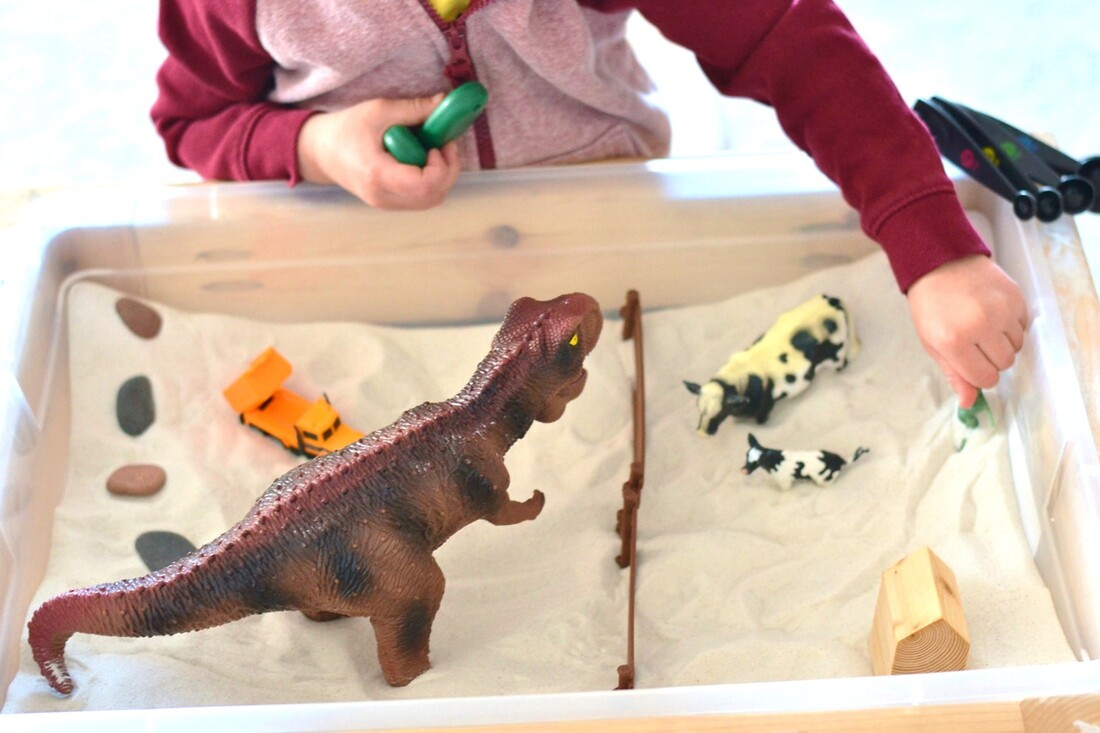|
Combining Eye Movement Desensitization and Reprocessing (EMDR) and Play Therapy is one of my most favorite ways to work with young people!
If you don’t know about EMDR, it is an 8 phase model of therapy for the treatment of trauma developed by Dr. Francine Shapiro. As an EMDRIA Approved Consultant I love to talk with other therapists about how engage children in trauma work combining EMDR and Play Therapy techniques to make EMDR for children developmentally appropriate. I wanted to share the top 5 things you need to know about working with children, trauma and EMDR if you are thinking about getting trained in EMDR, or are already trained but aren’t quite sure where to start. EMDR Treats Trauma EMDR is based on the theory of Adaptive Information Processing (AIP) which asserts that psychopathology is due to memory processes of maladaptive encoding and/or incomplete processing of life experiences that are traumatic, disturbing, or adverse. This freezes the trauma in a state-specific form (with all the sights, sounds, tastes, smells, physiological reactions, and body sensations) in its own neural network, which makes it unable to connect with other memory networks that hold adaptive information. So, for example, when someone who is the victim of a dog bite comes into contact with a dog (a very lovely safe dog), they are not able to have an understanding (linking to adaptive information) that they have met a TON of safe and loveable dogs and only one dangerous one. Instead the frozen, maladaptively encoded, and incompletely processed neural network of the trauma is activated by the trigger of seeing a dog in the here and now and now all dogs seem extremely dangerous and the body begins to have a trauma response. When someone is triggered, the past (frozen neural network) becomes present. This maladaptive encoding and/or incomplete processing impacts one's ability to integrate the experiences in an adaptive manner. The very real threat of the dog in the past feels and experienced the exact same way in the present. Through the 8 phase model of EMDR a three pronged approach is used to target the past, present, and future. EMDR facilitates the resumption of normal information processing and integration by desensitizing the trauma and reprocessing the trauma memory to link up the frozen neural networks to networks that hold adaptive information. SO COOL. If you are curious about EMDR you can learn more it HERE! EMDR treats “small t traumas” When I was a bitty baby therapist and first started out in the field I heard the notion that most kids that present for therapy have some form of trauma, annnnd I couldn’t quite wrap my head around it. The majority of my intakes weren’t endorsing events like major car crashes, domestic violence, traumatic weather events, or physical or sexual abuse. At the same time I want to take great care to express that there are many things that clients don’t disclose, for many reasons, at intake that are happening in their lives or have happened. And in my practice today? It is very rare that someone comes into my office that doesn’t have some form of trauma. Wait…. Did I get a whole new caseload? Start working at a wildly different practice? Nope! My definition of trauma changed as I learned more about the neuroscience of trauma and theories such as Adaptive Information Processing. As I have used the powers of Play Therapy and EMDR to treat a wide range of traumatic events I have seen the transformational change reprocessing and integrating stuck and unprocessed memories has on functioning and level of symptoms. When we can stop chasing behavior and get to the root of the difficulties (ie a likely memory stuck and frozen in the neural network getting triggered by something in the present, causing the past to be present) the behaviors are no longer necessary. This is because the trauma doesn’t feel like it is happening in the here and now when a child is faced with a trauma trigger. When we think about current behaviors as adaptive given how the body is remembering and experiencing the trauma when triggered - the behaviors make sense. And it makes even more sense knowing that some trauma memories can trigger implicit memories (ie a "felt sense", somatic, or emotion memory) not just explicit (ie the things we consciously remember - pictures, sounds, tastes, etc.). This means that young people may FEEL a certain way (triggered, scared, unsafe, angry, sad, etc.) but aren't able to consciously connect it to a past trauma or trauma trigger. Trauma comes in all forms, and Dr. Shapiro differentiates big “T” trauma from small “t” trauma. She notes that Big “T” Trauma includes events that caused actual or threatened injury or sexual violation. Shapiro states that Small “t” Trauma are events that are emotionally distressing. She states that both Big “T” and Small “t” Trauma can both have comparable long lasting negative effects and can become the basis of current dysfunctional reactions or mental health difficulties. So, through training and experience I have witnessed the painful long term effects of events such as bullying, becoming ill when separated from a parent, parents minimizing, yelling, or name calling. And, I see the transformation that can happen once these memories are linked with the neural networks that hold adaptive information. So given this information - if you see kids there are definitely a wide variety of young people that will walk in your door with both big “T” trauma and small “t” trauma that can benefit greatly from this approach! EMDR needs to be done by a therapist fully trained in EMDR Hopefully this one is given but I wanted to detail out what the process is for being fully trained in EMDR. EMDR International Association (EMDRIA) has outlined the criteria for someone to be fully trained in EMDR. Usually this training is 40 hours long as well as 10 consultation hours on your use of EMDR with clients. There are some programs out there that will do an introduction EMDR program in a day, books that you can get, or other ways that you can become familiar with EMDR. However, I truly believe that being trained fully by an EMDRIA accredited program is not only a good idea but also ethical and necessary! So you are either one of two people - you know all about EMDR and are fully trained and totally are picking up what I am putting down OR you know a little bit about EMDR or maybe nothing at all. If the latter is you, you can check out how and where to take this amazing training HERE! Annnd if children are a large part of the population you see there are trainers that specialize more in working with children, so seeking out someone with this expertise for your initial training could be something to consider! Children benefit from EMDR I can’t tell you how many professionals I run into that were fully trained in EMDR with little to no training on how to adapt the protocol to use in their work with children. And I get it, there is SO much information to cover about trauma, AIP, and the EMDR protocol that when you put in some demonstrations, time for practice, and trying to highlight special topics there is not much time left for anything else. BUT because of this some draw the conclusion that it can’t really be done with children. OR it feels really cumbersome and complicated to translate the 8 phases into something that doesn’t feel too scary, overwhelming, or inappropriate developmentally for a young person. So here is why I think it is absolutely necessary to do EMDR work with children (who are a good fit of course)- first looking at the neuroscience of trauma! Neural circuits that are used over and over are strengthened. The saying “neurons that fire together wire together” by Donald Hebb is absolutely true. It is also a “use it or lose it” kind of thing. So - neural circuits that are not used are dropped or pruned. There are two waves of branching and connecting that are followed by a reduction and pruning - ages birth through three and ages 11/12 years old. So what this means is trauma that occurs in childhood can actually hardwire in a fight/flight/freeze trauma response rather than wiring for prosocial connection and engagement. If we can heal trauma before these crucial periods of neural cropping it sets children's brains up for success in their later teens and adult life. AND because children have less dense neural networks (ie less memories, experiences, connections) they actually process faster than adults! Furthermore research has found that EMDR can be used effectively with children four years old and up to treat trauma symptoms. And apart from the pages in a research journal I have seen this firsthand, and it is AMAZING! Kids can get it, they can engage, and they can do this hard work! EMDR must be adapted to use with children Most children need minor to significant adaptations to the standard protocol to be able to work through the 8 phases of the protocol. And typically the younger the child the more adaptations may be needed. And, to be honest if you ask a 5 year old to focus on any one thing while just sitting still you are not likely to be successful, especially with trauma work. EMDR and trauma work with children can be fun, engaging, and done with cooperation and willingness. Usually this means games, sand tray, combining with Play Therapy, bibliotherapy, or any number of different interactive activities. EMDR with children also means shifting how we administer Bilateral Simulation (BLS) to make it fun and engaging and being more visual with how to scale SUDS and VoC. It also means having a longer Phase 2 Preparation to get young people used to the materials they will be using and tasks they need to engage in during the desensitization and reprocessing phases. Now, your question might be - what next? How do I get started? I always suggest getting extra training from an EMDRIA CE provider who works with children as well as seeking out consultation with someone who specializes in working with kids. I also wanted to share my three favorite books to help you start to begin to put it all together! The first is from Ana Gomez - EMDR Therapy and Adjunct Approaches with Children: Complex Trauma, Attachment, and Dissociation. Ana takes you through step by step with the specific activities, games, and techniques she uses within the 8 phase model. Next is the book EMDR With Children in the Playroom: An Integrated Approach by Ann Beckley-Forest and Annie Monaco. This book does an excellent job of how to integrate EMDR with a prescriptive Play Therapy approach and use bilateral stimulation within Play Therapy. Lastly is Small Wonders: Healing Childhood Trauma with EMDR by Dr. Joan Lovett. Dr. Lovett applies a storytelling modeling of EMDR for work with younger children. Want to know more about trauma, EMDR, and children? Check out my training on Playing Through Phase 2: Combining Bibliotherapy and Play Therapy for Phase 2 of EMDR. Now what about you? If you are EMDR trained and work with children what do YOU want therapists to know? If you are thinking about getting trained in EMDR what questions do you have? Leave a comment below!
4 Comments
Connie
6/4/2021 02:55:52 am
I would like to get the training with kids and teens but I don’t see any scheduled upcoming training. I have take. Basic EMDR now want to learn the work with kids and teens. Thank you.
Reply
Ann
6/4/2021 06:27:15 am
Hi Connie! I am so excited you want to learn more with kids and EMDR! I have a new training for how to combine play therapy and bibliotherapy in the prep phase of EMDR (phase 2) coming out later in June! If you aren't already you can get on my email list (link below) to get an update when it comes out!
Reply
Jessica
6/16/2021 07:11:50 am
I want to take the training but I can't find in Spanish. Do you now if there training in Spanish?
Reply
Ann Meehan
6/16/2021 02:13:52 pm
Hi Jessica!
Reply
Leave a Reply. |
Hi, there!I'm Ann Meehan, an LPCC, Loading... Archives
July 2024
Categories
All
|
Privacy Policies | Terms of Use | Disclaimer
Contact
[email protected] | Copyright Meehan Mental Health Services 2022
Contact
[email protected] | Copyright Meehan Mental Health Services 2022





